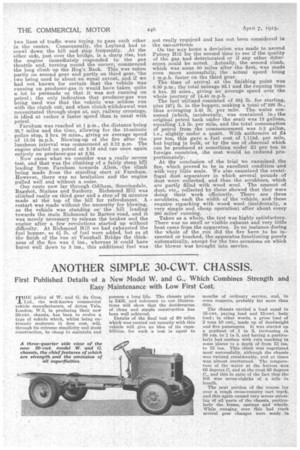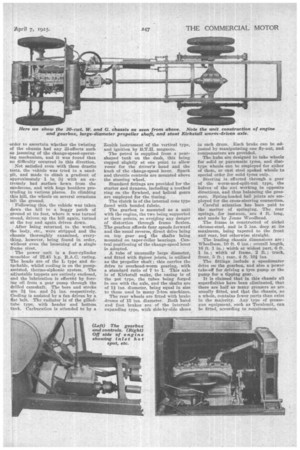ANOTHER SIMPLE 30-CWT. CHASSIS.
Page 12

Page 13

If you've noticed an error in this article please click here to report it so we can fix it.
First Published Details of a New Model W. and G., Which Combines Strength and Easy Maintenance with Low First Cost.
THE policy of W. and G. du Cros, Ltd., the well-known commercial vehicle manufacturers, of Acton Vale, London; W.3, in producing their new 30-cwt. chassis, has been to evolve a type of vehicle which, whilst being extremely moderate in first cost, will, through its extreme simplicity and stout construction, be cheap to maintain and
possess a long life. The chassis price is 1435, and reference to our illustrations will show that the desideratum of clean and simple construction has been well achieved.
Details of the final test of 90 miles which was carried out recently with this vehicle will give an idea of its capabilities. for such a test is equal to months of ordinary service, and, in some respects, probably far more than this.
The chassis carried a load equal to 35-cwt. paying load and 15-cwt, body load ; in other words, a gross load of 2 tons 10 cwt., made up of deadweight and five passengers. It was started up a gradient of 1 in 6, increasing in 50 yds. to 1 in 5, and having a particularly bad surface with ruts reaching in some places to a depth of from 12 ins. to 15 ins. This climb was negotiated most successfully, although the chassis was twisted considerably, and at times was almost overturned. The temperature of the water at the bottom was 66 degrees C. and at the crest 86 degrees C.. and this in spite of the fact that the hill was seven-eighths of a mile in length.
The next portion of the course lay over a rough cross-country cart track, and this again caused very severe stressbig of of all parts of the chassis, particularly the frame, springs and wheels. While running over this bad track several gear changes were made in
order to ascertain whether the twisting of the chassis had any ill-effects such as jamming of the change-speed-operating mechanism, and it was found that no difficulty occurred in this direction.
Not satisfied even with these drastic tests, the vehicle was tried in a sandpit, and made to climb a gradient of approximately 1 in 3* with an extremely bad surface hewn from the sandstone, and with huge boulders pro-. trading in various places. In climbing this hill, the wheels on several occasions left the ground.
Following this, the vehicle was taken down the hill to a boggy patch of ground at its foot, where it was turned round, driven' up the hill again, turned at the top and again driven down.
After being returned to the works, the body, etc., were stripped and the chassis thoroughly examined, everything, however, being found in order, without even the loosening of a single frame rivet.
The power unit is a four-cylinder monobloc of 21145 h.p. R.A.C. rating. The heads are of the L type and detachable, whilst cooling is on the pumpassisted, thermo-siphonic system. The adjustable tappets are entirely enclosed, and the lubrication is effected by forcing oil from a gear pump through the drilled camshaft. The bore and stroke are 3i ins. and 5* ins. respectively. Cooling is assisted by a fan driven by a fiat belt. The radiator is of the gilled. tube type, with header and bottom tank. Carburation is attended to by a
Zenith instrument of the vertical type, and ignition by E.T.H. magneto.
The petrol is supplied from a pearshaped tank on the dash, this being cupped slightly at one point to allow room for the driver'1 hand and the knob of the change-speed lever. Spark and throttle controls are mounted above the steering wheel.
Standard fittings are provided for the starter and dynamo, including a toothed ring on the flywheel, and helical gears are employed for the timing.
The clutch is of the internal cone type faced with bonded fabric.
The gearbox is mounted as a unit with the engine, the two being supported at three points, so avoiding any danger of distortion through frame EIC3d0D. The gearbox affords four speeds forward and the usual reverse, direct drive being on top gear an, the shafts being mounted an taper-roller bearings. Central positioning of the change-speed lever is adopted.
A tube of unusually large diameter, and fitted with Spicer joints, is utilized as the propeller shaft; this carries the drive to overhead-worm gearing, with a standard ratio of 7 to 1. This axle ia of Kirkstall make, the casing is of the pot type, the tubes being forged in one with the axle, and the shafts are of 14 ins, diameter, being equal in size to those used in many 2-ton machines,
The rear wheels are fitted with brake drums of 15 ins. diameter. Both hand and foot brakes are of the internalexpanding type, with side-by-side shoes in each drum. Each brake can be adjusted by manipulating one fly-nut, and compensators are provided.
The hubs are designed to take wheels for solid or pneumatic tyres, and disctype wheels can be employed for either of them, or cast steel spoked wheels to special order for solid tyres only.
Steering is effected through a gear of the worm-and-split-nut type, the halves of the nut working in opposite directions, and thus balancing the pressure. Spring-loaded hall joints are employed for the cross-steering connection.
Careful attention has been paid to the matter of springing. .The rear springs, for instance, "are 4 ft. long, and made by Jonas Woodhead.
The frame is constructed of nickel chrome-steel, and is 5 ins, deep at its maximum, being tapered to the front and rear, but otherwise straight.
The leading chassis dimensions are : Wheelbase, 10 ft. 6 ins.; overall length, 16 ft. 1 in.; width at widest part, 6 ft. 1 in.; width of frame, 2 ft.; track, front, 5 ft.; rear, 4 ft. 10* ins.
The fittings include a speedometer drive on the gearbox, and also a power take-off for driving a tyre pump or the pump for a tipping gear.
It is claimed that in flats chassis all superfluities have been eliminated; that there are half as many greasers as are usually fitted, and that the chassis, as a whole, contains fewer ports than exist in the majority. Any type of greasegun equipment, such as Tecalemit, can be fitted, according to requirements.




























